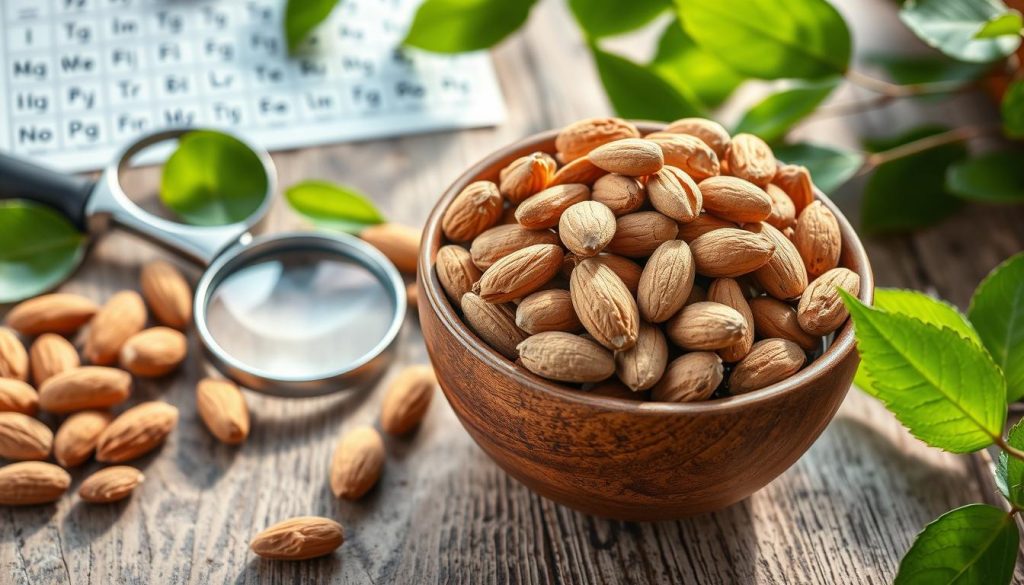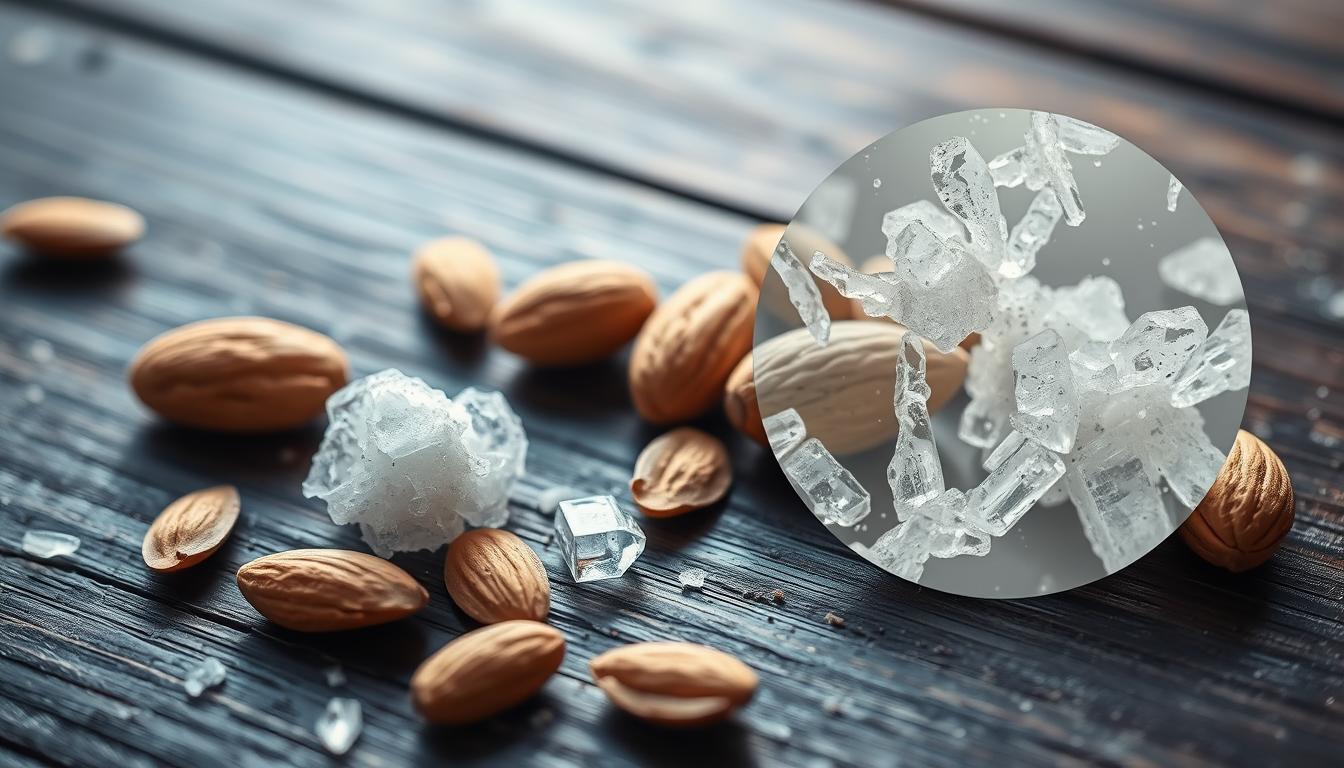Discover the Surprising Oxalate Content in Almonds
Do you know how oxalates in almonds affect your health? Almonds are a favorite snack, but they have a lot of oxalates. This can be bad for people with kidney stones or other health problems. It’s important to know how much oxalate is in almonds to keep your diet healthy.
Almonds have a lot of oxalates, which is something to think about when you eat them. The amount of oxalate in almonds can change, but they are generally high in oxalates. Knowing about the oxalate in almonds helps you make better food choices. This can lower your risk of kidney stones and other health issues.
Key Takeaways
- Kidney stones are a common issue that can be influenced by diet and oxalate intake.
- Almonds contain high levels of oxalates, which can be problematic for people with kidney stones.
- Understanding the oxalate content in almonds is critical for a healthy diet.
- The oxalate levels in almonds can vary, but overall, almonds are a high-oxalate food.
- Eating almonds in moderation can help reduce the risk of kidney stones and other health issues.
- A balanced diet that considers oxalate intake can help prevent kidney stones and other health problems.
Understanding Oxalates and Their Role in Nutrition
Oxalates are compounds found in plants and are key to our nutrition. They are in foods like spinach, berries, and nuts, including almonds. Knowing about oxalates is important because they can lead to kidney stones in some people.
Some people are more sensitive to oxalates and may get kidney stones, thyroid issues, or joint pain. Foods like almonds can make these problems worse. But, there are ways to lower oxalates in almonds, making them safer for sensitive individuals.
What Are Oxalates?
Oxalates are compounds that can bind to minerals like calcium, iron, and magnesium. This can lead to mineral deficiencies. They can also cause kidney stones by forming calcium oxalate.
Why Oxalates Matter in Diet
Knowing about oxalates is key for good health. A diet full of oxalates can harm joints by causing instability and pain. Reducing foods like almonds can help manage symptoms for those sensitive to oxalates.
Natural Sources of Oxalates
Oxalates are in many plant foods, including spinach, berries, and nuts like almonds. Foods like almond flour have lower oxalate levels, making them safer for sensitive people. Being aware of oxalate levels in foods helps make better diet choices and reduces health risks.
The Truth About Oxalate in Almonds
Almonds are a favorite snack, but they have a lot of oxalates. This can raise the risk of getting kidney stones. Oxalate is found in many foods, including almonds. Too much of it can harm our health.
Knowing how almonds and kidney stones are connected is key. Almonds are good for us, full of healthy fats, protein, and fiber. But, their high oxalate levels are a worry for some.
Here are some important points to remember:
- People at high risk should eat less than 50mg of oxalates a day.
- Most men eat about 214mg of oxalates daily, and women about 185mg.
- Vegetarians are 31% more likely to get kidney stones than non-vegetarians.
When it comes to almond health benefits, we must consider both sides. Almonds are good for us, but we should watch their oxalate content. It’s best to eat them in moderation.
Comparing Almond Oxalate Levels to Other Foods
It’s important to compare almond oxalate levels to other foods. Almonds have a lot of oxalates, with 469 milligrams in 100 grams of roasted almonds. This is a lot, which is why it matters for those who eat a lot of almonds or worry about oxalates and calcium.
Here’s a look at foods with high, medium, and low oxalate levels:
- High-oxalate foods: spinach, rhubarb, almonds
- Medium-oxalate foods: beets, Swiss chard, sweet potatoes
- Low-oxalate alternatives: cucumbers, bell peppers, carrots
If you want to cut down on oxalates, knowing about almonds and other foods is key. Making smart food choices can help lower your risk of problems like kidney stones. This way, you can enjoy almonds’ health benefits while keeping oxalate levels down.
| Food | Oxalate Content (per 100g) |
|---|---|
| Almonds | 469mg |
| Spinach | 600mg |
| Rhubarb | 700mg |
Health Implications of Consuming High-Oxalate Almonds
Eating foods high in oxalates, like almonds, can raise the risk of getting kidney stones. Almonds and kidney stones have been connected in studies. This shows the need to eat almonds in moderation. It’s key for those with kidney stone issues or other health problems.
Eating a balanced diet with almond health benefits is good. But, it’s important to know the risks of too much oxalate. High oxalate levels might cause kidney stones, harm to mitochondria, and inflammation. This could lead to arthritis, heart disease, and a weak immune system.
To lessen risks, eating almonds in small amounts is advised. Almond nutrition oxalate can be managed by watching overall oxalate intake. Eating almonds with foods high in calcium can also help.
For those who eat high-oxalate almonds, here are some tips:
- Eat almonds in moderation to avoid too much oxalate.
- Balance almond eating with other nutrient-rich foods.
- Eat almonds with foods high in calcium to help bind oxalates.
Different Forms of Almonds and Their Oxalate Content
Almonds come in many forms, like raw, roasted, almond flour, and almond milk. Each type has a different amount of oxalate. This can change based on how they are cooked or processed. Knowing the oxalate levels in these forms helps people choose what almonds to eat.
There are ways to lower oxalate in almonds. For example, soaking and cooking them can reduce oxalate levels. But, even cooked almonds have more oxalates than many other nuts.
Raw Almonds
Raw almonds are a favorite snack and seen as healthy. But, they have a lot of oxalate. This can be a problem for people with certain health issues. The oxalate in almonds can mix with calcium in the body, which might lead to kidney stones.
Roasted Almonds
Roasted almonds have less oxalate than raw ones, but not by much. Roasting can slightly lower oxalate levels. Yet, almonds are generally higher in oxalates than other nuts.
Almond Flour and Almond Milk
Almond flour and almond milk are good substitutes for regular flour and milk. But, they also have a lot of oxalate. This is something to think about for those who eat them often.
| Form of Almond | Oxalate Content |
|---|---|
| Raw Almonds | High |
| Roasted Almonds | Medium-High |
| Almond Flour | Medium |
| Almond Milk | Low-Medium |
In conclusion, knowing about the oxalate in different almond forms is key. It helps people make smart choices about eating almonds. By understanding the oxalate in raw, roasted almonds, almond flour, and almond milk, we can cut down on oxalate intake. This can help avoid health problems linked to almonds and calcium oxalate.
Who Should Monitor Their Almond Consumption?
People with certain health issues should watch their almond intake. Almonds and kidney stones are a big concern because of the high oxalate. Research shows that those with kidney stones or kidney disease should limit their almond eating.
When thinking about almonds, it’s important to look at the almond nutrition oxalate levels. Almonds are good for you, full of healthy fats and protein. But, their high oxalate content needs careful thought. Eating almonds in moderation can help you enjoy their benefits without risks.

It’s smart to talk to a doctor before eating almonds, if you have health problems. Knowing the good and bad of almonds helps you eat them safely. This way, you can enjoy almonds while keeping your diet balanced and healthy.
Methods for Reducing Oxalate in Almonds
If you’re worried about the oxalate in almonds, there are ways to lower it. You can soak and cook almonds to reduce oxalate. Also, pick almond products that have less oxalate.
Almonds and oxalate can lead to kidney stones. Soaking almonds in water can cut down on oxalate. Cooking them also helps, but how much depends on the method.
Here are some good ways to lower oxalate in almonds:
- Soaking almonds in water for several hours
- Cooking almonds using methods like boiling or roasting
- Choosing almond products that have been processed to reduce oxalate content
Using these methods, you can enjoy almonds while keeping oxalate levels down. Remember, almonds will always have some oxalate. So, eat them in moderation. Knowing how almonds and oxalate relate can help you make better food choices and lower kidney stone risk.
| Method | Oxalate Reduction |
|---|---|
| Soaking | 10-20% |
| Cooking | 20-30% |
| Processing | 30-50% |
Balancing Almond Benefits with Oxalate Concerns
Almonds are packed with nutrients like dietary fiber, vitamin E, and more. But, they also have a lot of oxalate, which can be a problem for some. It’s important to weigh the good stuff against the possible risks.
Almonds have a lot of dietary fiber, which can mess with minerals like calcium and phosphorus. Yet, they’re good for your heart, digestion, and bones. This makes them a valuable part of a healthy diet.
It’s key to eat almonds in small amounts because of their oxalate. A 100-gram serving of roasted almonds has about 469 milligrams of oxalate. Here are some tips for eating almonds:
- Stick to 1/4 cup of nuts or a tablespoon of nut butter per meal on a keto diet.
- Soaking nuts in water overnight can help with digestion.
- It’s important to eat nuts in moderation, even more so for those on a keto diet with high oxalate or phytic acid nuts.
In short, almonds can be a great part of a healthy diet if eaten in small amounts. This way, you can enjoy their benefits while keeping an eye on their oxalate content.
| Almond Serving Size | Oxalate Content |
|---|---|
| 1 ounce (23 kernels) | 3.5 grams of fiber, approximately 100-150 milligrams of oxalate |
| 100 grams of roasted almonds | approximately 469 milligrams of oxalate |
Signs You Might Be Sensitive to Oxalates
Some people might be sensitive to oxalates, which can be found in foods like almonds. This sensitivity can cause health problems, such as kidney stones. It’s important to know the signs of oxalate sensitivity to stay healthy.
Signs of oxalate sensitivity include kidney stones, thyroid issues, fibromyalgia, vulvodynia, and yeast infections. These symptoms might mean you’re intolerant to oxalates. Knowing these signs helps you cut down on oxalate foods in your diet. Foods high in oxalates, like almonds, can increase the risk of kidney stones.
To handle health problems linked to oxalates, it’s key to eat fewer oxalate-rich foods. Slowly cutting down on these foods by ten percent each week is best. This approach helps avoid worsening symptoms. Adding probiotics and binding agents, like activated charcoal, helps remove oxalates from the body. Being aware of both the good and bad in almond health benefits helps you make better food choices. This can lower the risk of kidney stones and other health issues.
Practical Tips for Including Almonds in a Low-Oxalate Diet
If you want to add almonds to your diet but keep oxalate levels low, follow some key tips. To reduce oxalate in almonds, control how much you eat and when. This is important for those with kidney stones, as almonds and calcium oxalate can be a problem.
Limit your almond intake to a small handful each day. This helps lower oxalate levels and reduces kidney stone risk. Also, know the oxalate in almond products like almond milk and flour. This helps you make better choices.
Portion Control Guidelines
- Eat a small handful of almonds per day
- Choose low-oxalate almond products
- Be mindful of the serving size of almond-based snacks
By following these tips, you can enjoy almonds’ health benefits while keeping oxalate intake low. This is a simple way to stay healthy and lower kidney stone risk.
Alternative Nuts and Seeds with Lower Oxalate Levels
If you want to cut down on oxalates, there are many nuts and seeds to choose from. Macadamia nuts and pecans are tasty and good for you. They have less oxalate levels in almonds than almonds do.
It’s important to know that too much oxalate can lead to kidney stones. But, picking nuts and seeds with less oxalate can help. This way, you can reduce oxalate in almonds easily and safely.
Here are some nuts and seeds with less oxalate:
- Macadamia nuts: rich in healthy fats and low in oxalates
- Pecans: a good source of antioxidants and minerals, with lower oxalate levels compared to almonds
- Other low-oxalate alternatives: hazelnuts, pistachios, and cashews
Adding these nuts and seeds to your meals can be healthy. They let you enjoy nuts without too much oxalate. Always talk to a doctor or dietitian for advice on what’s best for you.
| Nut/Seed | Oxalate Level | Health Benefits |
|---|---|---|
| Macadamia nuts | Low | Rich in healthy fats, antioxidants |
| Pecans | Low | Good source of antioxidants, minerals |
Conclusion: Making Informed Decisions About Almond Consumption
The almond nutrition oxalate content is key when adding almonds to our meals. Almonds have many health benefits, but knowing about oxalate in almonds is important for those sensitive to it. This knowledge helps us enjoy almonds’ good points while avoiding possible issues.
Choosing to eat almonds depends on our health needs and any sensitivities. Being aware and controlling portion sizes lets us enjoy almonds’ taste while keeping our health in check.






